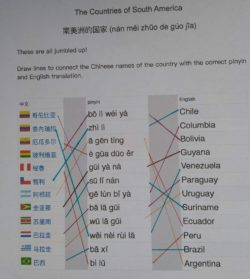Teaching the Ventriloquist's Daughter (3)
We are delighted that our Teaching Consultant and Advisory  Board member Dr Theresa Munford, of St Gregory's School in Bath, has created a blog series for us on the practicalities of using an authentic text to create a Y10 scheme of work. The text she has chosen is The Ventriloquist’s Daughter by Lin Man-chiu, translated by Helen Wang.
Board member Dr Theresa Munford, of St Gregory's School in Bath, has created a blog series for us on the practicalities of using an authentic text to create a Y10 scheme of work. The text she has chosen is The Ventriloquist’s Daughter by Lin Man-chiu, translated by Helen Wang.
Part 3. 18th June 2018
Lesson 3: The Countries of South America
Rationale:
The names of the countries in South America give the students an ideal opportunity to see how words in foreign languages are transliterated into Chinese, so the first exercise is a kind of detective game to see if they can work out which is which.
During Y10, they have studied sentence patterns to do with placement/ proximity/ cardinal directions etc so the map serves as an ideal platform for revisiting those patterns through framing questions and answering questions in Chinese such as ‘Is Peru close to Brazil’, ‘Where is Paraguay?’ ‘Is Paraguay to the north of Argentina?’ Chain questioning is a good way of doing this eg student A asks student B and question, then student B asks student C…etc etc.
Because this is a small class, to make ‘chain questions’ like this more random and to keep them all involved, I use coloured counters (Tiddly winks), each student knows their colour and I pull the counters randomly from a pot to decide who should ask/answer a question.
New content is the weather/scenery vocabulary – the students have touched on this during Year 9 and 10 (and we often remark on the weather when we write the date at the beginning of each lesson), but the map on the smart board gives them a chance to expand on this. Unit 8 of the AQA textbook also focusses on this topic so they will have that with them when they do the homework.

 Reading from the original text (Beginning of Chapter 3 where Liur receives a postcard from the ‘end of the world’) is a good example of the Dad describing where he is and is also quite an emotional scene in the story.
Reading from the original text (Beginning of Chapter 3 where Liur receives a postcard from the ‘end of the world’) is a good example of the Dad describing where he is and is also quite an emotional scene in the story.
The postcard homework is for writing practice, but is also so we can start building towards the display we are hoping to create in the coming weeks.
Review
They enjoyed the matching exercise and the detective work it required to piece the names together and it also led to a discussion of how close to the original word the transliteration was. Luckily we have a Spanish native speaker in the class so they could hear the country names in authentic Spanish and see how the transliteration is often much closer to the original Spanish than it is to the English (eg 秘鲁 sounds much closer to the Spanish pronunciation of the country than the name in English)
We spent longer on the spontaneous speaking section than planned but this is important as speaking often gets neglected and is going to be a key skill in the new GCSE format. This gave us less time for the text so we looked mainly at the descriptive words and didn’t get time to discuss the idea of the ‘世界的尽头’
They enjoyed choosing their countries for the homework – one chose Peru just because of the Paddington Bear association, another Surinam because she had never heard of it.
Downloads
